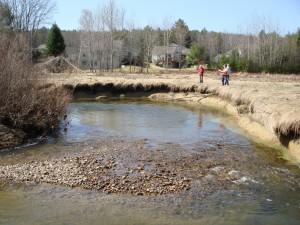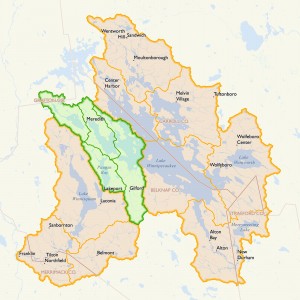
Introduction
The almost two dozen towns within the Winnipesaukee River watershed share a vast natural resource - to plan for its future takes shared vision, state of the art science and a strong partnership among all interests.
Water does not heed political boundaries. Within the Winnipesaukee River watershed, that truth is abundantly clear — its 485 square miles include portions of 23 different towns. To make the planning process for this diverse region more efficient, residents from smaller groups of subwatersheds are working together to develop management plans in phases – plans that will then collectively form a comprehensive Lake Winnipesaukee Watershed Management Plan.
The Meredith, Paugus, and Saunders Bay Sub-watershed Management Plan actually represents the second plan to be developed in the Winnipesaukee watershed; in 2005 a watershed management plan was completed for Lake Waukewan. The management plan for the Waukewan watershed is being updated in 2014 through a Watershed Assistance grant from the NH Dept. of Environmental Services awarded to the Lake Winnipesaukee Association. The update will be an ‘a-i’ compliant plan that will help ensure future implementation funding from sources such as NHDES and the U.S. EPA.
Local community members have worked with scientists and planners from the region to develop this plan. It has required understanding the lake’s current water quality, setting local water quality goals—especially regarding phosphorus loading, predicting future water quality trends based upon land use changes, identifying ways to reduce nutrient inputs, and establishing ongoing monitoring to evaluate how well those strategies are working.
We must now show the larger public how well these measures can work – how well they are currently working where they have been implemented in our communities, and we must continue to implement, review, and update this plan, so it can be a living document guiding the protection of our lake’s water.
BACKGROUND Return to Top
In 2006, North Country Resource Conservation and Development Area Council, Inc. brought together representatives from the communities of Meredith, Laconia and Gilford for the purposes of forming a subwatershed advisory group to address concerns regarding water quality protection of the lake and its watershed across jurisdictional boundaries.
These three communities were chosen as the pilot group to begin the subwatershed approach for several reasons, including the facts that each community employs professional planning staff, and each community recently conducted a local study on watershed planning or water resource protection.
Following that initial effort, the Lakes Region Planning Commission, along with the project partners, received a Watershed Assistance Grant Clean Water Act Section 319 Funds from the U.S. EPA to develop a Watershed Management Plan for the Meredith, Paugus, and Saunders Bays subwatersheds, which is presented here.
MISSION STATEMENT Return to Top
The mission adopted by the Meredith, Paugus, Saunders Bay Subwatershed Advisory Committee (MPSB) is:
Work collaboratively as stakeholders to assess issues and concerns that impact our shared watershed resources; develop a management plan that will educate, motivate and be a catalyst for action that protects those resources for the people and communities of the Lake Winnipesaukee Watershed.
SHARED VALUES Return to Top
A pristine Lake Winnipesaukee is an important focal point for Gilford, Laconia and Meredith in many different ways:
- Lake Winnipesaukee contributes significantly to the size, diversity and stability of each of the local property tax bases.
- Lake Winnipesaukee attracts private investment to our towns and the region providing considerable opportunity and value to the investor.
- Lake Winnipesaukee is integral to our local economies and to the regional economy (tourism, commercial recreation, hospitality, employment).
- Lake Winnipesaukee provides an abundance of recreational opportunities including swimming, boating and fishing that are enjoyed by residents and visitors alike.
- The water quality of Lake Winnipesaukee should not represent a threat to the public health of those that experience Lake Winnipesaukee.
- Lake Winnipesaukee is an important source of public drinking water.
- Municipalities expect to maintain local control over land use decisions.
- The numerous qualities of life associated with our position in the Lakes Region of NH motivate us to live, work and play here.
STATE OF THE SCIENCE Return to Top

Erosion along Gunstock Brook, Henderson Rd., Gilford
We have high quality water today, but the overall long-term trend in lake water quality is negative and the decline in water quality is expected to continue unless existing and future pollution sources are controlled.
Review of the relevant science of water quality monitoring and management tells us:
- Human activities on the land and water have created an over-abundance of nutrient and chemical inputs, some known and monitored, others only suspected, thereby altering the lake’s natural ecosystem which promotes a more rapid decline in water quality.
- Empirical water quality trend data and physical evidence from Lake Winnipesaukee confirms that water quality is declining due to increased levels of phosphorus and subsequent increased concentrations of chlorophyll-a (algae) in the lake that decreases visibility.
- The relationship between elevated levels of total phosphorus (TP) and declining water quality are well established
- The lake functions like a collection of interrelated embayments – each has differing characteristics and land-based influences, and in-lake responses to nutrient inputs. Thus, management should be done for each embayment, accounting for these characteristics.
- Embayments, such as Meredith Bay, have documented short term reductions in water quality (decrease in water clarity, and increases in algal and cyanobacteria blooms indicating a vulnerability to periodic nutrient inputs. This condition is found in other embayments on Lake Winnipesaukee as well.
- If the current concentrations of Total Phosphorus in the lake continue to rise we should likely expect:
- More frequent and sustained algal bloom events throughout the season
- Decreases in water clarity
- Increased cyanobacteria blooms, which increases the threat to public health and would result in increased beach advisories
- Decreased oxygen levels, which negatively affect fish condition and reproduction, and will lead to an increase in internal phosphorus loading from bottom sediments into the lake water
- Failure to support designated uses of swimming, fishing, boating
- Failure to support drinking water use even after adequate treatment
- Diminished property values
- Decreased revenues from real estate and tourism-based businesses
SHARED GOAL Return to Top
Lake Winnipesaukee is a shared resource. Our communities share the benefits of being located on “The Lakeâ€. We share the risks associated with degradation of this resource. We also share the responsibility of effective watershed stewardship, essential to the successful long term health of Lake Winnipesaukee.
The fundamental goal of this watershed management plan is to halt or minimize further water quality degradation attributable to nutrient inputs, primarily phosphorus in order to maintain our high quality water.
Current total phosphorus (TP) levels in Meredith, Paugus, and Saunders Bays are below the state standard of 8.0 ug/L established for high quality water.
We will work toward maintaining or improving current total phosphorus levels by stabilizing nutrient inputs through the reduction of nutrient sources. We will manage landscape change to limit nutrient loads through stormwater management, adoption of low impact development techniques, innovative land use planning, and installation of best management practices.
Our locally derived strategies are purposeful, considerate and comprehensive. Our approach embodies flexibility allowing us to achieve our stated goal while meeting the diverse needs and capacities of all watershed stakeholders.
ACKNOWLEDGMENTS Return to Top
The Lakes Region Planning Commission facilitated the planning process in the development of the watershed management plan for Lake Winnipesaukee, Phase 1: Meredith, Paugus, and Saunders Bays and would like to thank all of the partners and committee members that volunteered their time and support in this effort to foster long term stewardship of the land and water within the Winnipesaukee watershed.
Meredith, Paugus, & Saunders Bays Watershed Management Plan Steering Committee
- Town of Meredith
John Edgar, Community Development Director
Angela LaBrecque, Town Planner
Ed Touhey, Planning Board
Ralph Pisapia, Conservation Commission
- City of Laconia
Shanna Saunders, City Planner
Seth Creighton, Asst. Planner
Claude Richer, Planning Board
Scott McPhie, Conservation Technician
Dean Anson, Conservation Commission
Deb Mosher, Conservation Commission
- Town of Gilford
John Ayer, Town Planner
John Morgenstern, Planning Board
Lee Duncan, Conservation Commission
- North Country Resource Conservation and Development Area Council – Rick DeMark, Program Coordinator; John Hodsdon, Board of Directors; Pat Tarpey, Watershed Project Manager
- Lake Winnipesaukee Watershed Association – Dean Anson, President
- Lakes Region Planning Commission – Erica Anderson, Senior Planner; Pat Tarpey, Project Planner
Water Quality Advisory Committee
- Dean Anson, President, Lake Winnipesaukee Watershed Association
- Paul Currier, Watershed Management Bureau Administrator, NH DES
- Andrew Chapman, Clean Lakes Program, NH Department of Environmental Services
- Steve Landry, Watershed Assistance Section, NH Department of Environmental Services
- Jeff Schloss, Water Resources Specialist, UNH Center for Freshwater Biology
- Pat Tarpey, Water Quality Monitoring Coordinator, North Country RC&D
- Erica Anderson, Lakes Region Planning Commission
Project Partners
- Lakes Region Planning Commission (LRPC)
- Lake Winnipesaukee Watershed Association (LWWA)
- North Country Resource Conservation & Development (NC RC&D)
- Plymouth State University Center for the Environment
- Belknap County Conservation District (BCCD)
- University of New Hampshire Center for Freshwater Biology
- New Hampshire Department of Environmental Services (NHDES)
- Communities of Meredith, Laconia, and Gilford
- Gilford Conservation Commission
- City of Laconia Conservation Commission
Lakes Region Planning Commission and Staff
- Kimon Koulet, Executive Director
- Erica Anderson, Senior Planner
- Pat Tarpey, Project Planner
- Anne Deely, GIS Analyst
Water Quality Monitoring – 2009 and 2010
Meredith Bay:
- Bruce Bond, lake monitor
- Angela LaBrecque, lake monitor
- Town of Meredith, financial sponsor
Paugus Bay:
- Dean Anson, lake monitor
- Betty Anson, lake monitor
- Pat Tarpey, lake monitor
- City of Laconia Conservation Commission, financial sponsor
Saunders Bay:
- Jim MacBride, lake monitor
- Alan Sherwood, lake monitor
- Janis McKittrick, lake monitor
- David Beardsley, lake monitor
- Cathy Hunt, lake monitor
- Jim Boselli, lake monitor
- Chuck Coons, lake monitor
- Pat Tarpey, lake monitor
- Marc Read, lake monitor
- Emma Read, lake monitor
- Town of Gilford Conservation Commission, financial sponsor
- Gilford Rotary Club, financial sponsor
- Governor’s Island Association, financial sponsor
- Winnipesaukee Yacht Club, financial sponsor
In addition, we would like to thank the many volunteers, Fay’s Boat Yard, Goodhue & Hawkins marina, Paugus Bay Marina, NH Marine Patrol, UNH, Plymouth State University, and NH DES who all made the first ever “spring ice out” sampling a huge success!
Top photo from LakesRegionAerials.com


